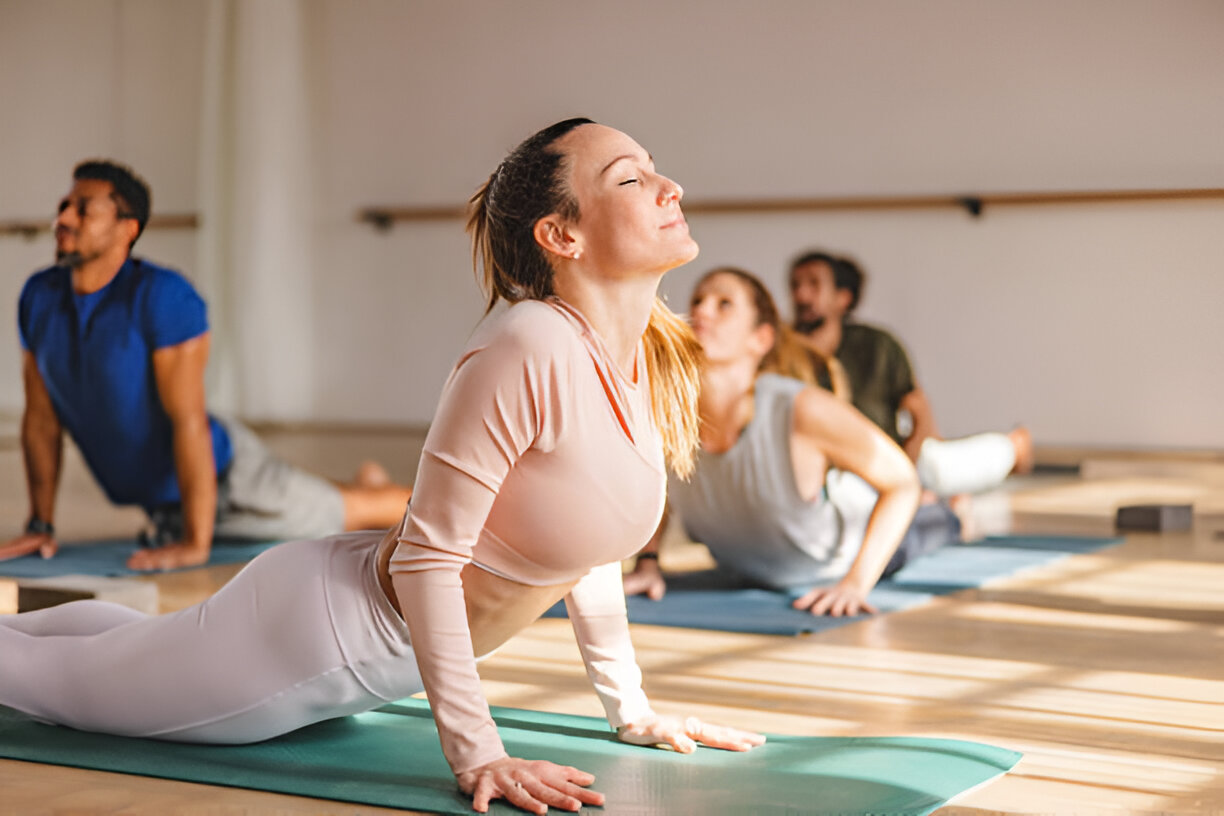Our eyes work hard every day, especially with increased screen time. These gentle yoga exercises, known as "netra vyayama" in traditional yoga, can help relieve eye strain and may support overall eye health. Remember to do these exercises without wearing glasses or contact lenses, and stop if you feel any discomfort.
Important Notes Before Starting
- Practice these exercises in a seated position with a straight back
- Do them in the morning or evening when your eyes feel fresh
- Take slow, steady breaths throughout
- If you have serious eye conditions, check with your doctor first
Palming for Eye Relaxation
Palming is one of the most soothing exercises for tired eyes. It helps reduce eye strain and brings a sense of calm to your mind.
How to Do It: Rub your palms together vigorously for about 10 seconds until they feel warm. Close your eyes and place your warm palms gently over them, creating a cup shape. Make sure no light enters your eyes. Keep your elbows rested on a table for support. Hold this position for 1-2 minutes while taking deep breaths. Feel the warmth seeping into your eyes and imagine darkness and calmness. Repeat this 3-4 times.
Benefits:
- Relieves eye strain and fatigue
- Helps calm the mind
- Reduces stress around the eye area
- Provides much-needed rest to overworked eyes
Up and Down Eye Movement
This exercise strengthens the eye muscles that control vertical movement and helps improve focus.
How to Do It: Sit comfortably with your spine straight. Keep your head still and move only your eyes. Look up towards the ceiling as far as comfortable, then look down towards the floor. Move slowly and consciously. Repeat this movement 10 times. Close your eyes and rest for 20 seconds. Do three sets of this exercise.
Benefits:
- Strengthens vertical eye muscles
- Improves eye coordination
- Helps reduce strain from looking at screens
- May help with focus and concentration
Side-to-Side Eye Rolling
This exercise works on your horizontal eye muscles and helps maintain eye flexibility.
How to Do It: Keep your head straight and move your eyes from left to right, as far as comfortable without straining. Move slowly and deliberately. Look to the extreme left, hold for a second, then move to the extreme right and hold. Do this 10 times, then close your eyes and rest for 20 seconds. Repeat the set three times.
Benefits:
- Strengthens horizontal eye muscles
- Improves eye movement control
- Helps maintain eye flexibility
- May reduce eye strain headaches
Diagonal Eye Movement
This exercise combines multiple eye movements and helps improve overall eye muscle strength.
How to Do It: Look diagonally up towards the right corner, then move your eyes diagonally down to the left corner. Next, look diagonally up towards the left corner, then down to the right corner. Make sure your head remains still throughout. Do this movement 10 times, then rest with closed eyes for 20 seconds. Complete three sets.
Benefits:
- Works multiple eye muscles simultaneously
- Improves eye coordination
- Enhances eye flexibility
- Helps maintain overall eye health
Clock Eye Rotation
This exercise works all eye muscles in a circular pattern and is excellent for overall eye strength.
How to Do It: Imagine a large clock face in front of you. Starting from 12 o'clock, move your eyes slowly clockwise, pausing briefly at each hour position (12, 3, 6, and 9). Complete five clockwise rotations, then five counterclockwise rotations. Rest your eyes for 20 seconds. Do three complete sets.
Benefits:
- Exercises all eye muscles
- Improves eye mobility
- Enhances eye muscle control
- Helps maintain eye flexibility
Near and Far Focus
This exercise helps improve eye focus and may help reduce eye strain from constant close-up work.
How to Do It: Hold your thumb about 10 inches from your face. Focus on your thumb for 5 seconds, then look at something at least 20 feet away for another 5 seconds. Keep alternating between your thumb and the distant object 10 times. Rest for 20 seconds with closed eyes. Complete three sets of this exercise.
Benefits:
- Helps improve focus adjustment
- Reduces eye strain from close work
- Strengthens eye focusing muscles
- May help maintain natural focusing ability
Tips for Maximum Benefits
- Practice these exercises daily, preferably at the same time
- Start slowly and gradually increase duration
- Keep breathing steady throughout
- Never strain your eyes; movements should be comfortable
- Take breaks between exercises
- Stay well-hydrated during practice
When to Practice
The best times to practice these exercises are:
- Early morning when eyes are fresh
- During work breaks to prevent eye strain
- Evening time to relieve daily eye stress
- Before bedtime to relax eyes after a long day
Additional Eye Care Tips
Along with these exercises, maintain good eye health by:
- Taking regular breaks from screen time
- Maintaining proper lighting while working
- Eating a diet rich in vitamins A, C, and E
- Getting regular eye check-ups
- Protecting eyes from harsh sunlight
- Keeping proper distance from screens
Remember that while these exercises can help maintain eye health and reduce strain, they are not a replacement for proper medical care. If you experience persistent eye problems, consult an eye care professional. Practice these exercises gently and regularly for the best results, and always listen to your body's signals.
Latest Blog
Best Foods To Eat During Lack of Sleep
We all have been there – those nights, when you barely get 4 hours of sleep and still need to push through the next day. Whether it’s due to work, studies, travel or person commitments, lack of sleep can leave you feeling drained, fog and less energized. While nothing replaces a good quality sleep, best foods and drinks can help you power through the upcoming day, improve focus, boost energy and helps to recover from the sleep depriv...
Back Pain: Bad Habits That Are Hurting Your Back
Daily Habits That Secretly Damage Your SpineMany of us unknowingly engage in activities that harm our backs every day. Back pain has become increasingly common, affecting people of all ages and lifestyles. Understanding these harmful habits is the first step toward protecting your spine and preventing chronic pain.Poor Posture at Your DeskThe way you sit at your desk can make or break your back health. Slouching, hunch...
10 Natural Ways to Boost Your Metabolism Over 50
As you age, you might notice that maintaining a healthy weight or feeling energetic isn’t as easy as it used to be. After 50, your metabolism naturally slows down, which can lead to weight gain, fatigue, and a general sense of sluggishness. But don’t worry—there’s plenty you can do to give your metabolism a boost and feel your best. In this article, we’ll explore 10 natural, science-backed ways to rev up your metabolism over 50. Thes...











